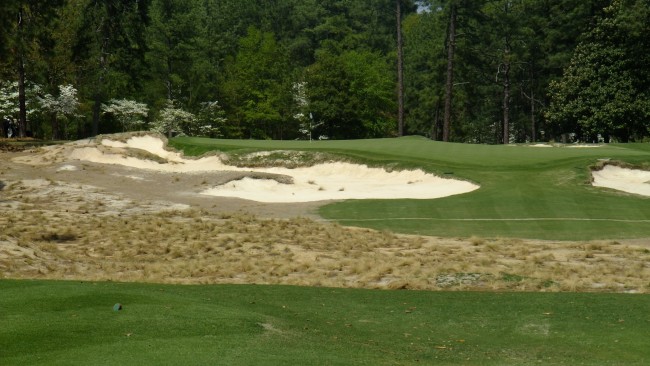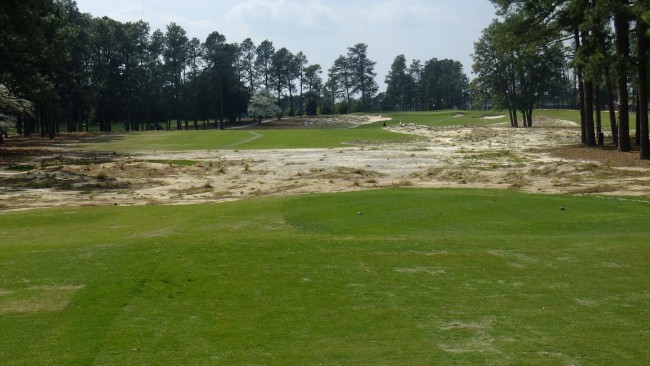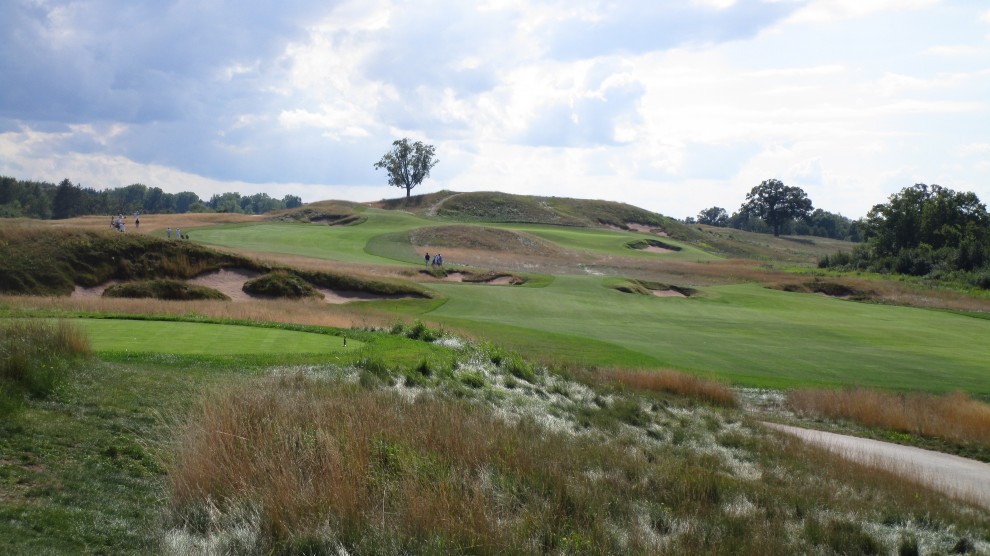When, in 2011, Pinehurst unveiled its No. 2 renovation in advance of the 2014 U.S. Open and U.S. Women's Open, it sparked – or perhaps a better word is rekindled – an evolving discussion about how golf courses can, and should, use less water.
There's a growing cacophony that today’s golfers have for too long been spoiled by the lush, immaculate greens and fairways offered by so many courses, saying that golfers need to be educated and enlightened to the many benefits of a more natural course and to learn that brown fairways do not always mean dead turf.
An average golf course might use upwards of 300,000 gallons of water in a year, a figure that varies wildly based on any number of factors including location, size, season and current weather. Turf grass requires enough water to keep it healthy and growing fast enough to recover from the golfer and vehicle traffic it endures each day. However, using water not only drains from strained resources but it also affects the bottom line, as the per-gallon cost surges, particularly in drought-stricken areas like California, where the government has intervened to make golf courses use drastically less water.
However, before the record California rain short fall took hold, Pinehurst grabbed golf circles with a bold, new-but-old look. Initial conversations about revamping No. 2 began back in 2008 during the U.S. Amateur.
“Many people in the golf industry, including the USGA's Mike Davis and the leadership team at Pinehurst, had the desire to restore the strategic elements of the sandy wiregrass roughs on Pinehurst No. 2,” said Bob Farren, Pinehurst’s Director of Grounds and Golf Course Maintenance. “These discussions led to the decision in 2009 to engage the team of [Bill] Coore and [Ben] Crenshaw to completely restore the course.”
Pinehurst had a stockpile of archival images, including a 1943 aerial photo and other documents to review during the fall and winter of 2009-10 and ultimately began the redesign process in the spring of 2010.
Farren said the project initially progressed very deliberately.
“It was very much a learn-as-you-go process,” Farren said. “We kept the training wheels on for several weeks as we began the process with very small steps and constantly going back with slight adjustments. We visited many holes with small tweaks as many as eight or 10 times. It was fascinating working closely with Coore and Crenshaw, Mike Davis and Don Padgett reviewing the process to uncover the elements of strategy and beauty.”
Channeling the spirit, passion and genius of original course designer Donald Ross, the attention to detail Farren talks about manifested itself by accomplishing the majority of the work using smaller equipment and hand tools rather than large excavation equipment.
“It was all about taking small steps with a great deal of patience,” Farren said. “The features were literally shaped and formed with much the same tools and process that Donald Ross would have used in the 1930s and 1940s, minus the horses obviously. I can honestly say that I would have done anything differently.”

Having enjoyed such great success with the 1999 and 2005 U.S. Opens, the 1991 and 1992 Tour Championships and the 1994 U.S. Senior Open, Farren admits there was some hesitancy and inherent risks involved in changing No. 2.
“It is easy to see why people would wonder why we needed to fix something that wasn't broken,” Farren said. “However, we were certainly able to see how the course had changed over the past 20 years and the value in restoring the natural elements that had made it the classic course that it was in its earlier days.”
According to Farren, annual water consumption on No. 2 has been reduced by as much as 60 or 70 percent due both to the redesign and the fact that Pinehurst stopped overseeding the course during the winter months – a move that has allowed the course to enjoy optimum playing condition levels in the fall season while also playing much drier and firmer in the spring and summer.
Farren admits that while environmental friendliness was not the impetus for the redesign, the benefits are evident nevertheless.
“We reduced the overall footprint of turf by 40 percent thus enabling us to focus our resources on the turf itself,” Farren said. “However, the native areas still require a significant amount of labor resources to manage them. We did not embark on the restoration as an environmental initiative or a cost savings initiative, though it has been a great platform to talk about economic and environmental sustainability.”

Golf has definitely seen an increased interest in more native and rugged course layouts through the exposure of championship golf at locations like Pinehurst, Kiawah Island, Whistling Straits, Chambers Bay, as well relative newcomers Bandon Dunes and Streamsong.
“We’ve been extremely pleased with the positive response to the No. 2 restoration from guests,” Farren said. “The vast majority of those who play No. 2 have really embraced the changes and love the fact that it, again, presents a unique test. And it extends beyond just our guests. Before, during and after the back-to-back U.S. Opens, we heard from players, officials, fans and media about the transformation of No. 2 and how it again has a distinct character off the tee to match what it's always had around the greens.”
Count LPGA star Stacy Lewis among that group.
Lewis had played the famed North-South amateur tournament a few times at Pinehurst but didn’t see the redesigned No. 2 in person until she visited about a month before the tournament.
“I loved the changes from the first time that I saw it,” said Lewis, who finished second behind winner Michelle Wie. “It felt like that was the way the course was supposed to be played. I didn’t really have any concerns about it. I loved the course even more as the tournament went on because of the variety the USGA gave us in the set up. I also liked how the course played differently each day.”
Lewis said she knew No. 2 would test the player’s short games, specifically chipping, so she focused her practice in advance of the major on having a variety of shots to go to around the greens.
“The toughest part were the shots around the greens,” Lewis said. “The runoff areas got worn out with divots as the week went on, so you just had to play different shots. I would love to see more courses like No. 2. It takes golf back to how it should be played, more links style, requires more shots and more creativity.”
Getting the everyday amateur player to fully buy in to the changes might take a bit more time. Farren said he believes there will always be those who simply don’t understand or agree with the natural appearance and native plants. And that’s just fine.
“That in itself is the beauty of golf courses,” Farren said. “They are all different and will appeal to some people and not to others. It is interesting that these same plants, when in the seedling stage, add a great deal of diversity with the flowering nature of them. Once these same plants are mature they are not as attractive or desirable thus requiring us to remove them. It is very seasonal by design.”
For the USGA – which fully supported the No. 2 restoration – resource management, and in particular water management, remains an issue of critical importance. One of the organization’s primary goals back in the early 1980s for the USGA Turfgrass and Environmental Research Program was to develop grasses that required less water and maintenance. That work continues today as the major issue for golf course sustainability.
“Since 1920, the USGA has funded more than $40 million on turfgrass research working with universities across the country,” said Kimberly Erusha, Managing Director for the USGA’s Green Section.
“The scientific results advance the long-term viability of the game through sustainable resource management and environmental protection. It takes considerable resources to advance this important work, and annually the USGA dedicates more than $5 million to these efforts. That said, we feel the return on investment for the golf community – both in terms of resource conservation and budget savings – easily justifies our long-term commitment to these efforts."
While Erusha acknowledges that some golfers may fear that reducing water use on their favorite course will make it less attractive, she counters that when water conservation practices are properly implemented, the contrast between highly maintained, irrigated areas and naturalized, unirrigated areas can in fact create an even more beautiful landscape.
“By carefully determining which areas can be naturalized and shifting saved resources to areas that come into play more often, golfers will find the course even more enjoyable to play,” Erusha said. “By combining new irrigation technology and agronomic principles, it is often possible to reduce the amount of water applied to golf course turf, without adversely impacting playing quality or turfgrass health.
“No two golf courses are alike and the game is influenced by the variations of nature. The work of the USGA focuses on the long-term sustainability of the game. Changing expectations to recognize that golf courses will have varying shades of green, treating rough as rough and bunkers as hazards, and better allocating resources to the primary playing areas of the course will better serve the future of the game.”
The USGA is taking the next step with its turfgrass resaerch, using low-cost GPS technology to take the guesswork out of how a golf course is actually being used by golfers. The player’s paths, or tracks, are overlaid onto a satellite image of the course, detailing the areas subject to the most wear and tear and indicating areas that could well be left to go native.
“By capturing the tracks of many players,” Erusha said, “it becomes obvious how the maintenance of the course can be altered to better utilize available resources.”
Bill Anderson, an agronomist with the Carolinas Golf Association, an organization that communicates golf course industry news of note to golfers in the Carolinas, including how it will affect them and the game of golf overall, said the issue of water conservation isn’t going away anytime soon.
“The use of water on golf courses will only become more restrictive and government controlled,” Anderson said. “There is a finite water supply available and golf will never be viewed as an entity that has equal water rights. We must plan and design for the future of golf using less water and natural resources.”
Anderson feels there has been a great deal of misinformation in the golf community and beyond about the realities of how much water courses actually use.
“The average person, whether a golfer or not, has heard inaccurate or misleading stories about how much water is used on golf course and how wasteful they are,” Anderson said. “We in the industry just need to keep getting the accurate story told as often as we can. Golf course superintendents don’t like to waste anything. Water is one of the most precious tools they have. Their golf courses depend on the proper use of water.”
Anderson said there are steps course superintendents can take to minimize water usage and set attainable conservation goals.
His top five include:
1. Reducing maintained acreage and allow for natural growth areas.
2. Extending the interval between irrigating to give more time for natural rainfall to occur.
3. Using turf varieties that work for the game of golf and use less water. Warm-season grasses are a good choice where feasible.
4. Installing or updating to a modern irrigation system with good coverage and good individual head control providing for better control by putting the water only where it is most needed and not over watering other areas.
5. Investing in new technology to find out where the water is needed. Sensors are now available to install in different course locations, which helps make the irrigation decision easier and more precise.
Like most change in golf, this evolution will take a long while. However, it's not for a lack of effort or interest. Golf is still learning how to golfers use courses, which will ultimately lead to best practices on how to turn untouched, overmanicured acreage into native scenery. At the same time, researchers continue developing new strains of heat- and salinity-resistant grasses that will save millions upon millions of gallons of water.
“Turf breeding and irrigation technology are the two areas of future advances in water saving,” Anderson said. “This type of research takes time and it will be years before we see these new grasses, but they are coming and will have a positive effect on golf.”

